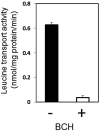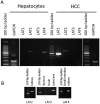Analysis of L-type amino acid transporter in canine hepatocellular carcinoma
- PMID: 25649314
- PMCID: PMC4478731
- DOI: 10.1292/jvms.14-0392
Analysis of L-type amino acid transporter in canine hepatocellular carcinoma
Erratum in
-
Analysis of L-type amino acid transporter in canine hepatocellular carcinoma.J Vet Med Sci. 2015 Jul;77(7):e1-2. doi: 10.1292/jvms.14-0392e. J Vet Med Sci. 2015. PMID: 26234626 Free PMC article.
Abstract
Analysis of L-type amino acid transport expression of hepatocellular carcinoma cells (HCCs) of the dog was performed. The leucine transport activity of canine HCCs was 0.628 ± 0.018 nmol/mg protein/min. The inhibitor of LAT 2-aminobicyclo[2.2.1]heptane-2-carboxylic acid (BCH) reduced 90% of the activity at 1 mM. The deduced amino acid sequences of canine LAT2, LAT3 and LAT4 were well conserved in mammalians, exhibiting 89, 88 and 77% homology, respectively. RT-PCR revealed distinct LAT1 expression compared with normal hepatocytes. Western blotting analysis confirmed the potent LAT1 expression in canine HCCs but not hepatocytes, and real-time RT-PCR analysis indicated that canine HCCs possessed 28 times higher LAT1 expression than hepatocytes. These results indicated that the leucine transport activity of canine HCCs was due to LAT1.
Figures








Similar articles
-
Downregulation of LAT1 expression suppresses cholangiocarcinoma cell invasion and migration.Cell Signal. 2014 Aug;26(8):1668-79. doi: 10.1016/j.cellsig.2014.04.002. Epub 2014 Apr 13. Cell Signal. 2014. PMID: 24726839
-
L-type amino acid transporter 1 (LAT1): a new therapeutic target for canine mammary gland tumour.Vet J. 2013 Oct;198(1):164-9. doi: 10.1016/j.tvjl.2013.06.016. Epub 2013 Jul 26. Vet J. 2013. PMID: 23896327
-
Canine Lat1: molecular structure, distribution and its expression in cancer samples.J Vet Med Sci. 2012 Jul;74(7):917-22. doi: 10.1292/jvms.11-0353. Epub 2012 Feb 10. J Vet Med Sci. 2012. PMID: 22322188
-
Thyroid hormone transport across L-type amino acid transporters: What can molecular modelling tell us?Mol Cell Endocrinol. 2017 Dec 15;458:68-75. doi: 10.1016/j.mce.2017.03.018. Epub 2017 Mar 21. Mol Cell Endocrinol. 2017. PMID: 28341457 Review.
-
Pharmacokinetic role of L-type amino acid transporters LAT1 and LAT2.Eur J Pharm Sci. 2008 Oct 2;35(3):161-74. doi: 10.1016/j.ejps.2008.06.015. Epub 2008 Jul 5. Eur J Pharm Sci. 2008. PMID: 18656534 Review.
Cited by
-
Carbon-11 and Fluorine-18 Labeled Amino Acid Tracers for Positron Emission Tomography Imaging of Tumors.Front Chem. 2018 Jan 15;5:124. doi: 10.3389/fchem.2017.00124. eCollection 2017. Front Chem. 2018. PMID: 29379780 Free PMC article. Review.
-
Expression of L-type amino acid transporter 1 in canine and feline intracranial tumors.J Vet Med Sci. 2022 Aug 1;84(8):1111-1117. doi: 10.1292/jvms.21-0646. Epub 2022 Jun 25. J Vet Med Sci. 2022. PMID: 35753782 Free PMC article.
-
Dairy consumption and hepatocellular carcinoma risk.Ann Transl Med. 2021 Apr;9(8):736. doi: 10.21037/atm-2020-ubih-06. Ann Transl Med. 2021. PMID: 33987434 Free PMC article. Review.
-
Glutamate dehydrogenase activator BCH stimulating reductive amination prevents high fat/high fructose diet-induced steatohepatitis and hyperglycemia in C57BL/6J mice.Sci Rep. 2016 Nov 22;5:37468. doi: 10.1038/srep37468. Sci Rep. 2016. PMID: 27874078 Free PMC article.
References
-
- Babu E., Kanai Y., Chairoungdua A., Kim D. K., Iribe Y., Tangtrongsup S., Jutabha P., Li Y., Ahmed N., Sakamoto S., Anzai N., Nagamori S., Endou H.2003. Identification of a novel system L amino acid transporter structurally distinct from heterodimeric amino acid transporters. J. Biol. Chem. 278: 43838–43845. doi: 10.1074/jbc.M305221200 - DOI - PubMed
-
- Betsunoh H., Fukuda H., Anzai N., Nishihara D., Mizuno T., Yuki H., Masuda A., Yamaguchi Y., Abe H., Yashi M., Fukabori Y., Yoshida K., Kamai T.2013. Increased expression of system large amino acid transporter (LAT)-1 mRNA is associated with invasive potential and unfavorable prognosis of human clear cell renal cell carcinoma. BMC Cancer 13: 509. doi: 10.1186/1471-2407-13-509 - DOI - PMC - PubMed
-
- Bartlett D. L., DiBisceglie A. M., Dawson L. A.2011. Cancer of the liver. pp. 997–1018. In: Cancer: Principles and Practice of Oncology, 9th ed. (De-Vita, V. T., Lawrence, T. S. and Rosenberg, S. A. eds.), Lippincott Williams & Wilkins, Philadelphia.
-
- Christensen H. N., Handlogten M. E., Lam I., Tager H. S., Zand R.1969. A bicyclic amino acid to improve discriminations among transport systems. J. Biol. Chem. 244: 1510–1520. - PubMed
Publication types
MeSH terms
Substances
LinkOut - more resources
Full Text Sources
Other Literature Sources
Medical
Molecular Biology Databases
Research Materials
Miscellaneous

